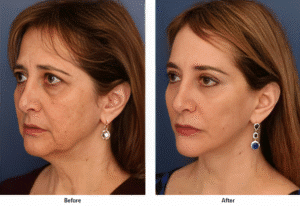
Dr. Ronald H. Schuster, board-certified plastic surgeon in Baltimore, Maryland, prefers the deep plane method because it goes beyond the surface and addresses the root causes of aging.
If you’re considering surgery, it can help to know what the healing process will look like. Dr. Schuster takes the time to walk you through recovery so you feel prepared.
The First Week After a Deep Plane Facelift
Recovery is a “process”. You have to trust the process. The first few days after a deep plane facelift tend to be the most challenging. You’ll feel groggy from anesthesia, and your face and neck may be swollen, bruised, or tight. We’ll place bandages and sometimes small drainage tubes to aid in healing. Dr. Schuster will send you home with medications to keep you comfortable and protect against infection.
Bandages and drains are removed at your first post op visit, usually 2-3 days after surgery. Drain removal does not hurt. Swelling usually peaks around days two to three. This is the time when you can look distorted because of the swelling. The swelling gives you a tight discomfort but actual pain is mild. You may shower the day the nandages are removed. Between days 2-5 it is not uncommon to feel a bit depressed, have the “blues”, get “cabin fever and even a little “buyer’s remorse”. We are very transparent about this and are always available to help you get through this brief period. Near the end of the first week, we remove your stitches, and the swelling will begin to settle. By the end of the swelling has much improved. You now look like yourself and you can see the light at the end of the tunnel. Remember to trust the process.
Two to Six Weeks Post-Facelift
You should like what you see by the two-week mark. Swelling and bruising are on their way out, and many people feel well enough to drive and run errands. Some lingering tightness or numbness is normal at this point. You usuually can return to social activities, especially with close friends who you feel comfortable around and can confide in. Any last traces of bruising can usually be covered with makeup.
Between four and six weeks, many patients are cleared to exercise, enjoy social events, and return to more active routines. Remember that your skin is still healing, so it’s essential to protect it from the sun.
Long-Term Healing
Your features will start to shine through in three to six months after most of the swelling has subsided. Scars fade into the background, and that early tightness finally relaxes.
In 4-6 moths, you’ll be fully healed and can enjoy the facelift results you worked for!
Learn More About Deep Plane Facelift Recovery
Deep plane facelift recovery takes patience. When you work with the right plastic surgeon, you know exactly what to expect and how to care for yourself along the way. To learn more about the process, call Ronald H. Schuster, MD, in Baltimore at 410-902-9800 to schedule a consultation.
